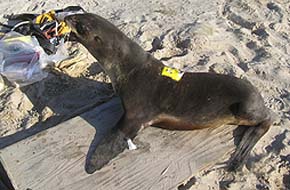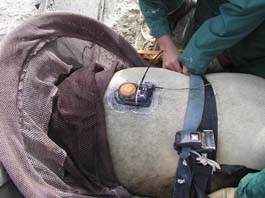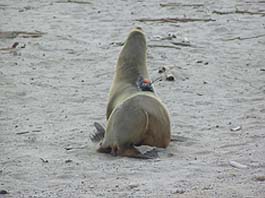California Current Ecosystem Program
San Miguel Island Research Program

Adult female northern fur seal at San Miguel Island, California, with satellite instrument attached in
November 2005. Photo by Tony Orr.
|
|
In collaboration with the Alaska Ecosystem Program (see previous article), the
California Current Ecosystem Program deployed satellite telemetry instruments on 10 adult female northern fur seals
at San Miguel Island, California, in November 2005. The Alaska Ecosystem Program simultaneously deployed instruments
on 20 adult females each at St. Paul Island in the Pribilof Islands and Bogoslof Island in the Aleutian Islands. The
goal of the study is to describe migration and movements of northern fur seals throughout the Northeast Pacific.
All the females departed the breeding colonies in late November. The females from San Miguel Island traveled northwest
from the colony along the central and northern California coast, and by January females had reached the California-Oregon
border (40° N). Females from the Alaska breeding colonies traveled south through the Aleutian passes and into the Gulf of
Alaska, California Current, and other areas of the Northeast Pacific. By January some females were reaching the transition
zone off the Canadian-U.S. border, while others were traveling southward offshore along the Pacific coast.
Northern fur seals utilize multiple ecosystems during the annual life history cycle. During the summer reproductive season,
northern fur seals feed in ecosystems near their breeding colonies in Alaska, Russia, and California. During the winter,
they travel long distances to ecosystems with different oceanographic dynamics and prey communities in search of food to
support the energetic demands of pregnancy and the pup rearing through the next reproductive season. The results of this
study will provide an ecosystem-based foundation for understanding the role of seasonal oceanographic features and prey
distribution in population trends of northern fur seals throughout their range.
 |
 |
|
FastLoc global positioning system instrument attached to adult female California sea lion at San Miguel Island,
California, November 2005. Photos by Tony Orr. |
The California Current Ecosystem Program deployed 10 satellite telemetry and three global positioning system (GPS) FastLoc
instruments on adult female California sea lions at San Miguel Island in November 2005. The study is a collaboration with
the University of California, Santa Cruz, Tagging of Pacific Pelagics (TOPP) program. Researchers at the University of
California instrumented 10 adult females at San Nicolas Island, California, 60 miles southeast of San Miguel Island during
the same time period.
The focus of the study is to describe winter dispersal and foraging behavior of adult females from the two populations.
Food habits data and previous foraging distribution studies suggest that adult females from the two populations feed in
different feeding areas along the central California coast.
The GPS FastLoc instruments are prototypes produced by Wildlife Computers. When the instruments are recovered in late
January, they will provide detailed movements and diving data at a higher resolution than that available through satellite
telemetry instruments currently available. Such information will allow a finer scale to interpret habitat requirements for
the species and will assist management agencies in evaluation of potential resource conflicts between fisheries and
California sea lions in California.
By Sharon Melin
>>>continued
 |

|
OND2005 quarterly sidebar
AFSC Quarterly
Research Reports Oct-Dec 2005
Contents
Feature
ABL Reports
FMA Reports
NMML Reports
RACE Reports
REFM Reports
Milestones
Quarterly Index
Quarterly Home
|

